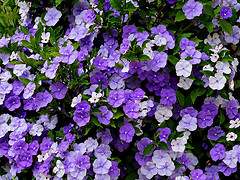Brunfelsia
 Question from Randy:
Question from Randy:
Yet another question. On page 403 in your book you say to feed a double dose of fish on a brunsfelsia. I have pretty good luck with this plant but I only feed it when the weather warms up. What is your reasoning for feeding this tropical plant when it’s so cold out? Just curious as to how you came up with this. Seems random.
Answer from Pat:
Great question! Your brunfelsia is not the one referred to in the December chapter of my book. You undoubtedly are growing a plant with the common name “Yesterday, Today, and Tomorrow” (Brunfelsia pauciflora). Continue to grow it as you are doing.
The plant to which I was referring is brunfelsia ‘Royal Robe’ or ‘Royal Purple’ (Brunfelsia pauciflora ‘Macrantha.’) This is a plant that never occurred naturally in the wilds. It is a man-made hybrid developed in greenhouses in Europe, I believe by de Gruyter Co. of Germany. It is so spectacular in bloom, especially in June, that it became a popular porch plant over thirty years ago in Southern California, but like many man-made plants it takes a trick to bring it into the best bloom. Additionally, it will bloom in more shade than almost any other plant. Here is where my book kicks in and tells you the weird fact that by feeding it double nitrogen fertilizer twice in winter this is how to make it bloom spectacularly in June.
You asked me my “reasoning”. I did not reason this out. In fact, it would never have occurred to me to do such a thing. I learned this trick from a great plantsman who died over 20 years ago, but taught me many of his secrets years earlier. I put all of these tips, tricks and special know-how into my articles and columns and later used them on television and later still in books.
There was at one time living in Southern California a brilliant plantsman and grower whose name was Bob Weidner. He and the late great Chuck Kline, Horticulturist of Sea World, got their training at the same time at the New York Botanical Garden as students of one of the most legendary teachers and plantsmen ever to teach horticulture in America. His name was Thomas A. Everett and he wrote the 10-volume New York Botanical Garden Encyclopedia of Horticulture, which is still one of the best things out there even though it is way out of date. (I have it in my library and still use it.) Years after studying with Everett, Bob Weidner came west, married his wife Evelyn, and settled in San Diego County where he and his wife founded Weidner’s Gardens Nursery in Leucadia.
Bob was the original importer of Bromeliad ‘Silver Vase’, the first-ever bromeliad used as a houseplant in USA. He also was the importer of many other great and innovative, pot plants, including ‘Royal Robe’ brunfelsia. He’d seen it in full bloom in Germany so he knew it was a wonderful pot plant, but when he brought it here he could not get it to bloom in Southern California’s outdoor temperatures. One day in sheer desperation Bob mixed up a batch of nitrogen fertilizer double strength and poured it over this plant’s roots in November. The plant perked up and within a couple of weeks the leaves turned dark green, so he did the same thing in December. Imagine his delight when in spring the plant developed many buds and the following June they all opened. The result was a plant that fairly dripped with blossoms. Bob then told this trick to me. I used it on my NBC television shows in the mid 1980’s and later put it in my book.
You used the word “random”. This is not that random. Do you know how the greatest of the Fallbrook bougainvillea growers used to get his bougainvilleas to burst into bloom so he could can send them to nurseries for sale in spring all covered in blossoms? About a month before he planned to sell them, he’d “shock” them into bloom by throwing a handful of sulfate of ammonia into each one-gallon and five-gallon pot and then watering it in. You would think all that nitrogen would kill the plants, but it doesn’t especially since the weather is not hot at that time of year. Maybe the plants think they are going to die, and in their attempt to leave progeny they cover themselves with flowers. Bob told this to me this bougainvillea trick also. I didn’t put this into my book since it’s not exactly something a home gardener would use. However, I do sometimes use strong nitrogen in one form or another to shock a recalcitrant bougainvillea into bloom when I want it to.

